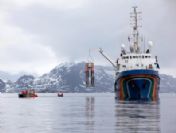Norway Scıence
NORWAY SCIENCEEPA02184798 A HANDOUT PİCTURE RELEASED BY GREENPEACE ON 03 JUNE 2010 SHOWS A 'SCİENTİST'S EYE VİEW' OF A PTEROPOD LOOKİNG İNTO THE EYEPİ

epa02184798 A handout picture released by Greenpeace on 03 June 2010 shows a 'scientist's eye view' of a pteropod looking into the eyepiece of a microscope in the marine laboratory at the Arctic scientific research station of Ny-Alesund in Svalbard, Norway, 30 May 2010. The pteropod, or 'sea butterfly', is a small marine animal threatened by ocean acidification. Pteropods are a fundamental part of the food web, commonly consumed by by fish, seabirdswhales. Like shellfish, coralsother molluscs, they need calcium carbonate (arogonite) to form their shellsstructures. However, increased CO2 emissions from human industry are causing ocean water to trend towards acidity, which is not only reducing the capability of these species to form shells, but actually causing existing shells to dissolve. The Greenpeace ship Esperanzaits crew are working with scientists from the German marine research institute IFM-GEOMAR to investigate ocean acidification, by deploying nine large 'mesocosms' in Kongsfjord, near Ny-Alesund. The mesocosms are being used to investigate future implications of ocean acidification, a phenomenon caused by carbon dioxide (CO2) emissions that has just as much potential to damage marine ecosystems as climate change. Absorption of excess CO2 pollution by seawater causes its PH level to drop, making it more difficult for creatures integral to the food web to form shellsskeletons. EPA/NICK COBBING - HANDOUT IMAGE AVAILABLE FOR DOWNLOAD BY EXTERNAL MEDIA FOR 14 DAYS AFTER RELEASE. TERMS OF HAND-OUT: NO RESALE, NO ARCHIVE, FOR EDITORIAL USE ONLY, NOT FOR MARKETING OR ADVERTISING CAMPAIGNS. EDITORIAL USE ONLY/NO SALES EDITORIAL USE ONLY/NO SALES
03.06.2010 10:52:03